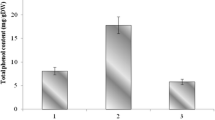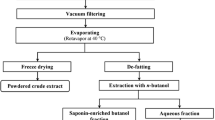Abstract
The aim of this research was to investigate the levels of phenolic compounds and antioxidant activities in different tissues including leaves, stems, and roots from baekseohyang (Daphne kiusiana). The highest contents of total phenolics (43.59 mg gallic acid equivalent, GAE/g) and flavonoids (15.73 mg rutin equivalents, RE/g) were observed in the 75% methanol extract of leaves. Moreover, this extract had the predominant antioxidant capacity, DPPH (85.91%) and ABTS (92.57%) radical scavenging activities as well as reducing power (7.20%) at a concentration of 5 mg/mL. The highest content of phenolic compounds was also exhibited in this extract with an increasing order in leaves, roots, and stems and their major components were vanillic acid (6.37 mg/g), tannic acid (1.91 mg/g), and p-hydroxybenzoic acid (3.96 mg/g). Thus, the strong antioxidant activities of the 75% methanol extract are correlated with high phenolic compound contents. This study suggests that baekseohyang leaves may potentially be used as an accessible source of natural antioxidants.
Similar content being viewed by others
References
Butsat S, Siriamornpun S. Antioxidant capacities and phenolic compounds of the husk, bran, and endosperm of Thai rice. Food Chem. 119: 606–613 (2010)
Bailey GS, Williams DE. Potential mechanisms for food related carcinogens and anti-carcinogens. Food Technol. -Chicago 47: 105–118 (1993)
Lee BW, Lee JH, Lee ST, Lee HS, Lee WS, Jeong TS, Park KH. Antioxidant and cytotoxic activities of xanthones from Cudrania tricuspidata. Bioorg. Med. Chem. Lett. 15: 5548–5552 (2005)
Ueda H, Yamazaki C, Yamazaki M. Luteolin as an anti-inflammatory and anti-allergic constituent of Perilla frutescens. Biol. Pharm. Bull. 25: 1197–1202 (2002)
Pietta PG. Flavonoids as antioxidants. J. Nat. Prod. 63: 1035–1042 (2000)
Halliwell B. Reactive oxygen species in living systems: Source, biochemistry, and role in human disease. Am. J. Med. 91: 14–22 (1991)
Tachakittirungrod S, Okonogi S, Chowwanapoonpohn S. Study on antioxidant activity of certain plants in Thailand: Mechanism of antioxidant action of guava leaf extract. Food Chem. 103: 381–388 (2007)
Sun T, Ho CT. Antioxidant activities of buckwheat extracts. Food Chem. 90: 743–749 (2005)
Ito N, Hiroze M, Fukushima G, Tauda H, Shira T, Tatematsu M. Studies on antioxidnat; their carcinogenic and modifying effects on chemical carcinogensis. Food Chem. Toxicol. 24: 1071–1081 (1986)
Toshihira N. Coumarin derivatives. V. Constituents of the bark of Daphne kiusiana Miquel and others (Thymelaeaceae). Yakugaku Zasshi 74: 192–193 (1954)
Zhang S, Bi H, Liu C. Extraction of bioactive components from Rhodiola sachalinensis under ultrahigh hydrostatic pressure. Sep. Purif. Technol. 57: 275–280 (2007)
Meda A, Lamien CE, Romito M, Millogo J, Nacoulma OG. Determination of the total phenolic, flavonoid, and praline contents in Burkina Fasan honey, as well as their radical scavenging activity. Food Chem. 91: 571–577 (2005)
Abeysinghe DC, Li X, Sun CD, Zhang WS, Zhou CH, Chen KS. Bioactive compounds and antioxidant capacities in different edible tissues of citrus fruit of four species. Food Chem. 104: 1338–1344 (2007)
Blois MA. Antioxidant determination by the use of a stable free radical. Nature 181: 1199–1200 (1958)
Fellegrin N, Ke R, Yang M, Rice-Evans C. Screening of dietary carotenoids and carotenoid-rich fruit extracts for antioxidant activities applying 2,2-azinobis(3-ethylbenzothiazoline-6-sulfonic acid) radical cation decolorization assay. Method. Enzymol. 299: 379–389 (1999)
Oyaizu M. Studies on products of browning reaction: Antioxidative activities of products of browning reaction prepared from glucosamine. Jpn. J. Nutr. 44: 307–315 (1986)
Javanmardi J, Stushnoff C, Locke E, Vivanco JM. Antioxidant activity and total phenolic content of Iranian Ocimum accessions. Food Chem. 83: 547–550 (2003)
Lee YL, Huang GW, Liang ZC, Mau JL. Antioxidant properties of three extracts from Pleurotus citrinopileatus. Lebensm. -Wiss. Technol. 40: 823–833 (2007)
Whistler RL, Sannella JL. Fractional precipitation with ethanol. Purification of hemicelluloses. Vol. V, pp. 34–36. In: Methods in Carbohydrate Chemistry. Whistler RL (ed). Academic Press, New York, NY, USA (1965)
Miliauskas G, Venskutonis PR, Van Beek TA. Screening of radical scavenging activity of some medical and aromatic plant extracts. Food Chem. 85: 231–237 (2004)
Pyo YH, Lee TC, Logendra L, Rosen RT. Antioxidant activity and phenolic compounds of Swiss chard (Beta vulgaris subspecies cycla) extracts. Food Chem. 85: 19–26 (2004)
Wong PYY, Kitts DD. Studies on the dual antioxidant and antibacterial properties of parsley (Petroselinum crispum) and cilantro (Coriandrum sativum) extracts. Food Chem. 97: 505–515 (2006)
Lee JH, Baek IY, Ko JM, Kang NS, Shin SH, Lim SG, Oh KW, Shin, SO, Park KY, Park KH, Tae JH. Antioxidant and tyrosinase inhibitory activities from seed coat of brown soybean. Food Sci. Biotechnol. 17: 1–7 (2008)
Marinova EM, Yanishlieva NY. Antioxidant activity of extracts from selected species of the family Lamiaceae in sun flower oil. Food Chem. 58: 245–248 (1997)
Choia Y, Jeonga H, Lee J. Antioxidant activity of methanolic extracts from some grains consumed in Korea. Food Chem. 103: 130–138 (2007)
Duan X, Wu G, Jiang Y. Evaluation of antioxidant properties of phenolics from litchi fruit in relation to pericarp browning prevention. Molecules 12: 759–771 (2007)
Shimada K, Fujikawa K, Yahara K, Nakamura T. Antioxidative properties of xanthan on the autoxidation of soybean oil in cyclodextrin emulsion. J. Agr. Food Chem. 40: 945–948 (1992)
Jin-wei L, Shao-dong D, Xiao-lin D. Comparison of antioxidant capacities of extracts from five cultivars of Chinese jujube. Press Biochem. 40: 3607–3613 (2005)
Romani A, Vignolini P, Galardi C, Aroldi C, Vazzana C, Daniela H. Polyphenolic content in different plant parts of soy cultivars grown under natural conditions. J. Agr. Food Chem. 51: 5301–5306 (2003)
Ferracane R, Graziani G, Gallo M, Fogliano V, Ritieni A. Metabolic profile of the bioactive compounds of burdock. J. Pharmaceut. Biomed. 51: 399–404 (2010)
Author information
Authors and Affiliations
Corresponding author
Rights and permissions
About this article
Cite this article
Lee, J.H., Seo, W.T., Lim, W.J. et al. Phenolic contents and antioxidant activities from different tissues of Baekseohyang (Daphne kiusiana). Food Sci Biotechnol 20, 695–702 (2011). https://doi.org/10.1007/s10068-011-0098-2
Received:
Revised:
Accepted:
Published:
Issue Date:
DOI: https://doi.org/10.1007/s10068-011-0098-2




